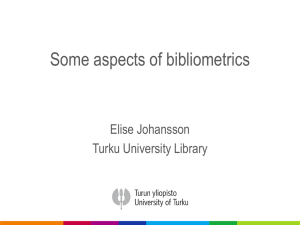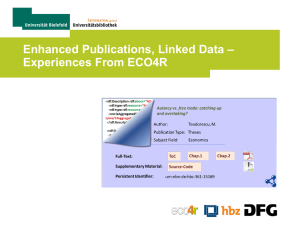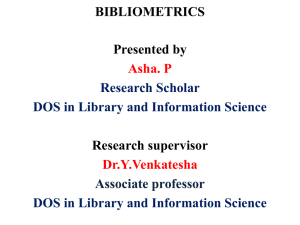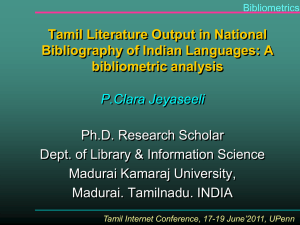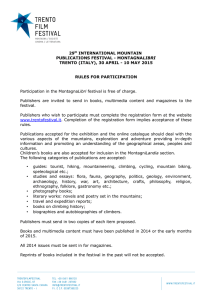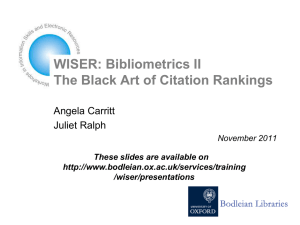Session 4 - Ulf Kronman (1)
advertisement
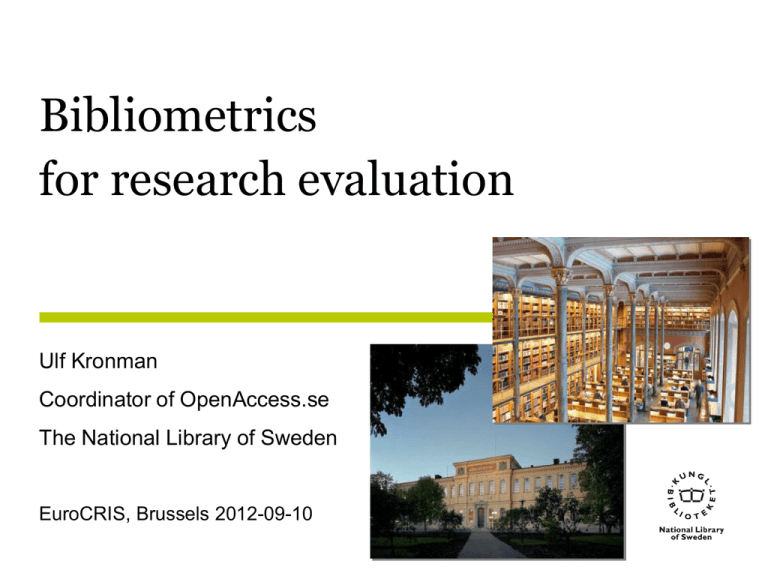
Bibliometrics for research evaluation Ulf Kronman Coordinator of OpenAccess.se The National Library of Sweden EuroCRIS, Brussels 2012-09-10 Parts of the bibliometrics session • A brief introduction to bibliometrics – Data sources – Methods – Indicators • A critical view on bibliometrics – Methodological issues, error margins and interpretation – How should bibliometrics be used? • Documentation: Nordic funding allocation schemes based on bibliometrics – The Norwegian/Danish/Finnish model – The Swedish model Bibliometrics – statistics on publications • Production: Publications – How many – per year, per researcher, per euro … – What kind – articles, conference papers, theses, books, reports … • Impact: Citations – Assumption: A cited publication has been read and made impact • Cooperation and networking – Which researchers/organisations/countries are publishing together? – Who is citing who and what is citing what? • Dynamics of scholarly publishing – Production, impact and cooperation put on a time axis Commercial data sources for bibliometrics • Thomson Reuters (ISI) Web of Science – 11 500 journal titles covered from 1970's and onwards – Started as Institute of Scientific Information (ISI) in the 1960's • Elsevier Scopus – 17 000 journals and conference proceedings covered from 1996 and onwards • Google Scholar – Collects ”everything" on the web – Also contains monographs, dissertations and reports • Subject specialized sources – PubMed, Chemical Abstracts, ArXiv, SPIRS, ... Institutional database (CRIS) for bibliometrics • Advantages – Better coverage – all document types covered – Verified data – known authors and organisations • Disadvantages – No clear definition of what scientific material to include – No citation analysis – No world data to compare with • Combining CRIS and commercial data source – Verified data and citations and world data Differing conditions for different research fields • Varying publication patterns – Varying use of publication types – Varying publication frequencies – Varying citation conventions and lengths of reference lists • Difference in coverage in bibliometric data sources – Medicine and natural sciences is well covered – Most publications are articles in international journals – Engineering is half-covered – Publishes in articles, conference proceedings and reports – Social sciences and humanities is poorly covered – Publishes in books and non-English regional journals Visibility of scientific publishing in Thomson database Web of Science's täckning i Norge 100% Journal articles 90% 80% Conference proceedings Reports 70% 60% Books 50% 40% 30% 20% 10% gi na le ko no Ö m vr i ig Ps sa yk m ol hä og lls i ve te ns ka p Hu m an io ra to lo k Na tio do n ni Te k O fa in & Natural sciences and medicine M ed ic gi M at em at ik lo Bi o rm ak o lo gi sik Fy n ici m ed Bi o Ke m i 0% Engineering and Social sciences Humanities Data from Norwegian Database for statistikk om høgre utdanning (DBH) Citations – a skewed distribution http://www.syque.com/quality_tools/toolbook/Variation/measuring_spread.htm Citations in relation to publication type and age Average citations related to age and document type 45 40 35 30 25 20 Review articles Original articles 15 10 5 0 Citations in relation to research field and age Average citation per original publication related to age and subject field 70 60 Cell Biology Immunology 50 Microbiology Oceanography Psychology 40 Plant Sciences Zoology Physics, Applied 30 Economics Sociology Veterinary Sciences 20 Law Mathematics Humanities, Multidisciplinary 10 0 1989 1990 1991 1992 1993 1994 1995 1996 1997 1998 1999 2000 2001 2002 2003 2004 2005 2006 2007 2008 Field normalized citation rate (cf "crown") • Normalization – compare publications that are alike • Field normalization compares publications with the world average for publications in: – The same field – The same publication year – Of the same publication type • The world norm is 1 – A value > 1 means more cited than the world average – A value < 1 means less cited Summary: Commonly used bibliometric indicators • Publications (P) • Citations (C) – Field normalized (cf) • Journals – Thomson Reuters Journal Impact Factor (JIF) • Researchers – h-index: h number of publications cited at least h times • Networks – Usually presented as visualizations Visualizations of bibliometric relation networks Does bibliometrics measure research quality? Methodological issues in bibliometric studies • Data source coverage and quality – Does the source cover the publishing of the analysed unit? • Data selection and validation – Is publication data verified or just selected by author name or address search? • Sample size and error margins – Is the data set sufficiently large for statistics? • Methods and indicator details – Fractionalization, citation windows, self-citations Inherent noise in the data material • Artifactual boundaries between groups creates noise – Analysis constructs boundaries between years, fields, journals and (sometimes) organisations • The researchers' publishing is somewhat "random" at the micro level – Choice of journal and publishing date – Choice of articles for reference list – Attribution of affiliated organisation • Random errors in data – Citation matching in Thomson system misses on average 6% of the citations due to spelling errors Citation mean is affected by a few publications A study of noise in time series of cf Årlig variation i fältnormerad citeringsgrad Yearly variation in field normalized citation rate 1.4 1.2 1 0.8 0.6 33/år 0.4 230/år 890/år 0.2 0 1999 2000 2001 2002 2003 2004 2005 2006 2007 Correlation between publication count and noise level in field normalised citation rate Confidence interval in relation to analysed number of publications 2.5 95% confidence interval 2 1.5 1 0.5 y = 2.06x-0.41 R² = 0.96 10 % noise level 0 1 10 100 Number of analysed publications (full count) 1000 10000 Does bibliometrics measure research quality? Yes, if: No, if: If the analysed unit publishes The research generates books, its findings in international reports, patents, popular journals articles or practical results Citations = impact = quality Citations indicate something else than quality The research is conventional and understood by many The research is young, specialized and breaks paradigms The data material is big (> 500 publications) The data material is small (< 50 publications) Bibliometrics is not diagnostic: It does not detect absence of quality How should bibliometrics be used? • As a statistical background material to be used by experts – A non-biased complement to subject and organisation knowledge • Bibliometrics works best at the macro level when used alone – Best suited for studies on 1000 publications or more Peer review Bibliometrics Countries Länder Universities Lärosäten Groups Grupper Individuals Individer 1 10 100 1000 Publikationer år Publications perper year 10000 100000 Using bibliometrics as performance metrics • Note the difference between statistical indicators and exact performance metrics • Bibliometric numbers are statistical indicators – Commercial data with skewed coverage – Non-transparent methods and statistical error margins – Works on macro level – large numbers needed • Performance metrics for funding are required to be exact – Preferably self-reported and ”self-established” – Transparent – Comparable between analysed units – Often used on micro level – departments, research groups and individual researchers Discussion: Why a hausse on bibliometrics? • Globalization of the scientific community – Global competition for researchers, students and reputation – University ranking lists • We are entering an era of knowledge – Research is the industry of the knowledge society – Universities are the factories of the knowledge society • Investments in research is a major financial undertaking today – How measure return on investments? • Very few measurable results from basic research – Publications and citations are two of the few measurable results from research Thanks for your attention! Questions? E-mail: ulf.kronman [at] kb.se Twitter: @UlfKronman Nordic national models for funding based on bibliometrics An overview of Nordic funding models • Norway (2004) – Publication based model with “channel” levels – Self-registered data + verified Thomson data – Author fractionalised • Denmark (2010) – Adapting the "Norwegian model" • Finland (2012?) – Introducing the "Norwegian model” • Sweden (2009) – Citation based model – Only (non-verified) Thomson data – Address fractionalised The Norwegian publication channel model • Introduced 2004 • About 2% of funding distributed based on publications • Publication records are self-registered • Records from Thomson can be reused • Three types of publications – Article in ISSN title = Article in journal – Article in ISBN title = Chapter in book – ISBN title = Book Publication channels divided into two levels • Level 2 consists of higher rated channels = journals and publishers – Scientific boards for each area decides on the channel levels • Publications in level 2 channels can at maximum represent 20% of the publications in each area • Approximately 20 000 channels have been rated – Level 2, Level 1, Level – (not considered as peer reviewed) Level 2: 20% of the publications gives higher publication scores Level 1: 80% of the publications gives normal publication scores Publication points in the Norwegian system Publication type Points level 1 Points level 2 Monograph (ISBN) 5 8 Article in journal (ISSN) Chapter in book (ISBN) 1 3 0.7 1 • Publication points for each publication is fractionalised between authors • Publication points are credited to universities in proportion to their share of authors to the publication Bibliometric funding model in Denmark • Decided for a modified “Norwegian model” in 2009 • Will be implemented gradually during 2010-2012 Publication type Level 1 Level 2 Scientific monographs 6 Scientific articles in journals 1 3 Scientific articles in anthologyseries with ISSN 1 3 Scientific articles in anthologies No level 0.75 Ph’d theses 2 Doctoral theses 5 Patents 1 The Swedish bibliometric funding indicator • Production * Impact – Field normalized publications * field normalized citations • Field normalised citations – A conventional bibliometric method exists • Field normalised publication production – No conventional bibliometric method exists – New innovative/experimental method was developed by bibliometric researcher/consultant Basic problems with the Swedish indicator • How compare publication volume between different research fields? • How handle areas with very low visibility in the Thomson database? – Arts, humanities and social sciences We need to add selfregistered publication data SwePub.se & n lo gi sik lo Bi o ak o Fy ici i do n ni to lo Te k k gi M at em at ik rm O fa Na tio in m ed 40% gi na le ko no Ö m vr i ig Ps sa yk m ol hä og lls i ve te ns ka p Hu m an io ra M ed ic Bi o Ke m Thomson + SwePub = full coverage? Web of Science's täckning i Norge 100% 90% 80% 70% SwePub data 60% 50% Thomson data 30% 20% 10% 0%
